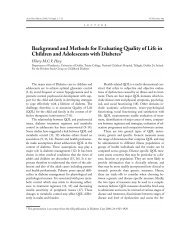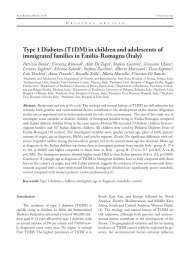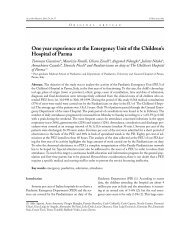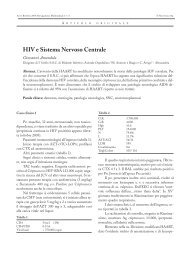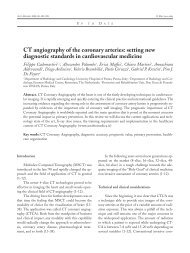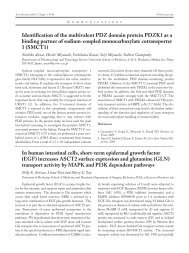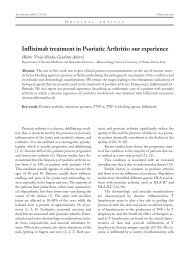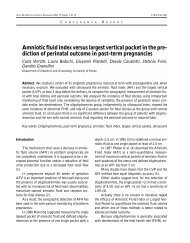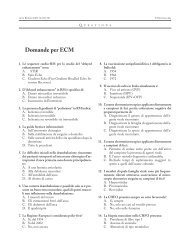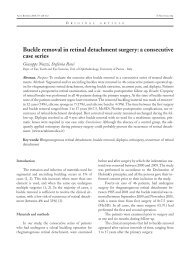Autoinflammatory diseases: the hereditary periodic fever syndromes
Autoinflammatory diseases: the hereditary periodic fever syndromes
Autoinflammatory diseases: the hereditary periodic fever syndromes
- No tags were found...
You also want an ePaper? Increase the reach of your titles
YUMPU automatically turns print PDFs into web optimized ePapers that Google loves.
96 P. Fiettain HIDS, amyloidosis has not been till now reportedand pleural involvement or myalgias are rare (36). During<strong>the</strong> acute episodes, leukocytosis with neutrophiliaand an intense APR occur, with a significant elevationof serum CRP, SAA, IL-6, TNF-α, IFN-γ, IL-1 receptorantagonist and both sTNFRSF1A and 1B levels(37, 38). Between attacks, stimulated peripheralblood mononuclear cells of HIDS patients in vitroproduce increased TNF-α and IL-1β amounts (39). Apersistent polyclonal hyperimmunoglobulinemia D(>100 U/ml) is <strong>the</strong> hallmark of <strong>the</strong> disorder (3, 35), despitenormal or low levels have been reported in somepatients (36). More than 80% of patients have also highIgA serum levels (3). An elevated urinary excretionof neopterin, a marker of activated cellular immune response,reflects <strong>the</strong> disease activity (40).HIDS is caused by recessive mutations in mevalonatekinase (MK, ATP: mevalonate 5-phosphotransferase)gene (MVK) at long arm of chromosome 12(12q24), encoding an enzyme predominantly localizedin peroxisomes and involved in cholesterol and isoprenoidbiosyn<strong>the</strong>sis (38, 41). The large majority of patientsare compound heterozygotes for two mutations,mostly of missense type, but deletion, absence of an alleleexpression, as well as novel polymorphisms havealso been found (41). The most prevalent is V377I, originatingfrom a common ancestor, likely of Dutch origin(42). In HIDS, <strong>the</strong> mutations determine a decreasedMK activity, however not so profound as in mevalonicaciduria, an affection characterized by a nearcompleteMK defect and a more severe clinical presentation,with episodic <strong>fever</strong>, dysmorphisms and mentalretardation (43). In both <strong>diseases</strong>, <strong>the</strong> MK defect causesincreased plasma levels of mevalonic acid, which isexcreted in enhanced amounts in <strong>the</strong> urine (41, 44).However, <strong>the</strong> relationship between isoprenoid endproductdeficiency and HIDS features is not completelyunderstood. Likely, <strong>the</strong> impaired prenylation ofproteins involved in <strong>the</strong> ligand-induced cellular activationmay have a role in <strong>the</strong> pro-inflammatory cytokinehyper-production that characterizes HIDS (45).At present, <strong>the</strong>re is no completely effective treatmentfor HIDS. If <strong>the</strong> excess of mevalonic acid was<strong>the</strong> cause of symptoms, <strong>the</strong> treatment with statinscould be beneficial. Instead, <strong>the</strong> experience with statinshas been disappointing, with severe inflammatoryattacks apparently provoked by <strong>the</strong> drug (3). There aresome anedoctal reports of benefits with nonsteroidalanti-inflammatory drugs (NSAIDs), corticosteroids,intravenous immunoglobulins, colchicine, cyclosporine,but not widely confirmed (3). In a recent trial, thalidomidehas failed to reduce <strong>the</strong> disease activity (46).Etanercept reduces <strong>the</strong> frequency of <strong>the</strong> flares and attenuates,but not suppresses, <strong>the</strong> HIDS clinical manifestations(47).Tumor necrosis factor receptor superfamily 1A-associated<strong>periodic</strong> syndromeTRAPS, formerly known as familial Hibernian<strong>fever</strong>, is a rare autosomal dominantly inherited HPFS,usually affecting Caucasians, mostly of nor<strong>the</strong>rn Europeanancestry, although recent reports highlight thatit is more common worldwide than previously appreciated(48). TRAPS was first described as a distinctnosologic entity in 1999 (49). The affection has relapsingand remitting nature, and <strong>the</strong> disease onsettends to be later and <strong>the</strong> duration of <strong>the</strong> attacks longerthan in o<strong>the</strong>r HPFSs (Table 2), with marked variabilityeven within <strong>the</strong> same family (6). The episodesusually last a week or more (48, 50, 51) (Table 2) and,sometimes, patients may experience a nearly continuousinflammation (1). The flares may be triggeredby emotional stress, exercise or physical trauma (6,50).Pregnancy can improve TRAPS symptomatology,whereas menses may exacerbate it (6) and post-partumhormonal state may induce attacks (50). The observedmale : female ratio is of 3 : 2, without genderspecificdifferences in phenotypic expression (6). Patientswith TRAPS present high-grade <strong>fever</strong> withchills, variably associated with sterile serositis,conjunctivitis, skin rash, arthralgia, and severe myalgias,which are nearly always present (6,48) (Table 2).Fever is practically constant in childhood, but may beabsent during some attacks in adults (6). Severe abdominalpain with nausea and vomiting is common andpleurisy is frequent. Testicular and scrotal pain may bepresent (6). An increased incidence of inguinal herniaamong men in some families has been reported (6).Distinguishing clinical features from o<strong>the</strong>r HPFSs aremono- or bilateral painful conjunctivitis and/or pe-



